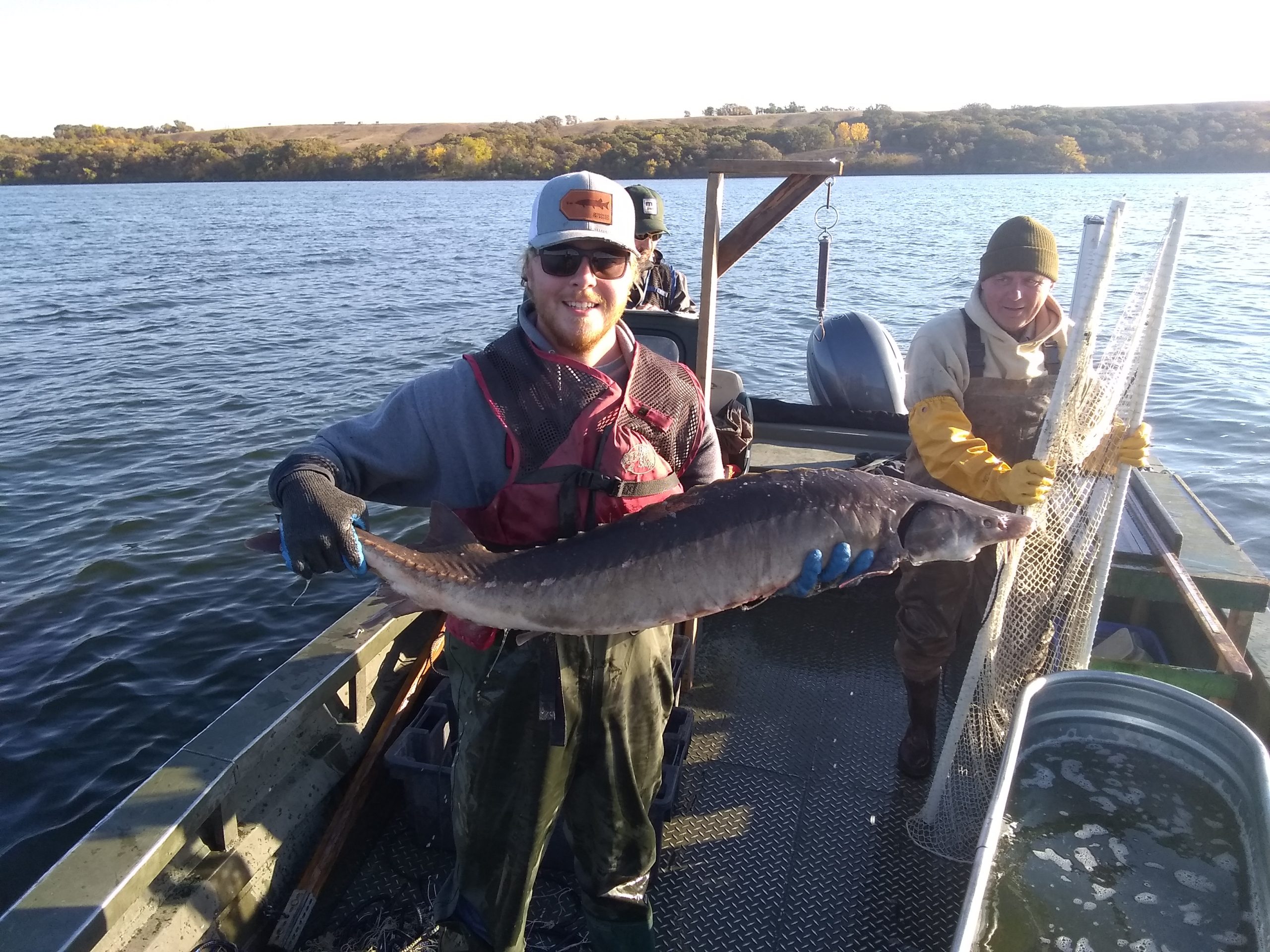By Brian Arola
Copyright minnpost

Lake sturgeon sightings on Big Stone Lake were few and far between until recent years.
BJ Bauer felt like each glimpse of Minnesota’s largest fish would prompt a call to his Ortonville office from an excited observer. The species generates that level of interest, said the Department of Natural Resources fisheries specialist, especially after such a long absence.
Once abundant in the long, narrow lake along Minnesota’s border with South Dakota, the native species were wiped out by 1946. Since the DNR began reintroducing fingerlings in 2014, the normally slow-developing fish has grown beyond expectations.
Researchers are now launching a three-year study seeking to learn more about Big Stone Lake’s sturgeon maturation, specifically how close the species is to naturally reproducing.
Findings by the South Dakota State University and U.S. Geological Survey teams, in partnership with the DNR and South Dakota Game, Fish and Parks agencies, could serve as a road map for the two states’ management strategies going forward.
The fish nearing or already reaching reproductive maturity would be a key milestone in the lake’s turnaround, Bauer said.
“It speaks good to the health of the lake,” he said. “The fact we could have this native species come back and thrive is a testament to some great stewardship with both states and multiple agencies and the public as well.”
Many factors behind decline
A confluence of factors contributed to the demise of Big Stone Lake’s sturgeon population. The same factors nearly eradicated them from Minnesota as a whole.
Described as a “living dinosaur of the fish world” by the DNR, the lake sturgeon faced a double-edged sword of threats in the 1800s and 1900s.
Growing to more than six feet in length and weighing more than 100 pounds, the fish developed a reputation as a nuisance to commercial fishing outfits because it could easily break through nets.
Mass harvesting on lakes and rivers resulted in sturgeon being stacked like logs on shore. Humans found plenty of uses for them.
Sturgeon eggs became caviar. Skin became leather. Oil became a fuel source. Swim bladders became isinglass, a gelatin used to clarify beer and wine.
Evolutionary characteristics made it harder for the fish to overcome such mass harvesting, said Nick Kludt, a DNR fisheries specialist involved in sturgeon restoration in the Red River basin.
Lake sturgeon can achieve long lifespans, reaching 55 years for males and more than 150 years for females. They develop slowly, taking up to 25 years for females to reach sexual maturity, with spawning only occurring once every three to six years.
Being in the slow reproduction lane was a sound evolutionary strategy for sturgeon for millenia, Kludt said. They were hardy, capable of weathering harsh conditions until the going got good enough to spawn.
When tough times strike, as they did in Minnesota in the 19th and 20th centuries, this slower reproductive pace works against them. The species was getting harvested faster than it could reproduce.
“In a 40-year window we were able to crash the population,” Kludt said.
Related: Two-wheeled birding is an avian adventure in the Twin Cities
Habitat loss and fragmentation, along with declining water quality, compounded the problem. In Big Stone Lake, one of the barriers to reintroducing sturgeon was undoing poor water quality caused in part by sewage being dumped into the body of water.
The proliferation of dams negatively impacted lake sturgeon habitats and migratory pathways. They need to swim freely through lakes and rivers to spawn, and dams cut off the routes.
Making up ground
Big Stone Lake’s sturgeon reintroduction came after decades of water quality work starting in the 1980s, helped by grants from the Environmental Protection Agency. It laid the groundwork for 6,500 fingerlings to be stocked in the lake in 2014. More than 44,000 total have been released in the years since.
Achieving natural reproduction would be a sign that the species is sustainable without additional outside intervention. As part of the study, researchers Steven Chipps and Alison Coulter, faculty members at South Dakota State, will use tags inserted in the fish to analyze their movements and blood samples to assess reproductive statutes.
“If we are able to document some reproduction, that would be a measure of success,” said Chipps in a story published by the university. “But in reality, what we really want to see in rebuilding this population is that young fish that are naturally produced grow up to be adults and return to spawning grounds years later to produce another generation of fish.”
What’s happening in Big Stone Lake resembles what multiple state, federal and tribal nation agencies accomplished to the north in the Red River basin. A 20-year stocking plan started in 2002. Dams and barriers were modified or removed to facilitate sturgeon passage.
By 2019, the DNR had identified the first sexually mature female lake sturgeon in the Red River basin. Three years later, the DNR documented spawning.
“That was the first time we were able to verify spawning of lake sturgeon in the river basin in more than 100 years,” Kludt said.
Surpassing the same yard sticks would be welcomed around Big Stone Lake. Bauer, who joined the DNR’s Ortonville office right after the first stocking of lake sturgeon, is eager to see how the species measures up in the study, as reports seem to indicate some of the fish are reaching sizes associated with sexual maturity.
“With the abundance of sturgeon we’re seeing out on the lake, we’re very pleased and encouraged by the survival rate of these young fish,” he said.
Big Stone Lake and the Red River basin’s sturgeon reports differ in one notable area, Kludt said.
“The growth rate can best be described as meteoric,” he said of Big Stone Lake’s sturgeon.
It has him particularly interested in the research project’s results. Sturgeon can speed up maturation to an extent, he said, but it would go beyond anything he’s seen for sturgeon to reach sexual maturity so fast.
“That would be exceptionally interesting if they had mature females at this point,” he said.



